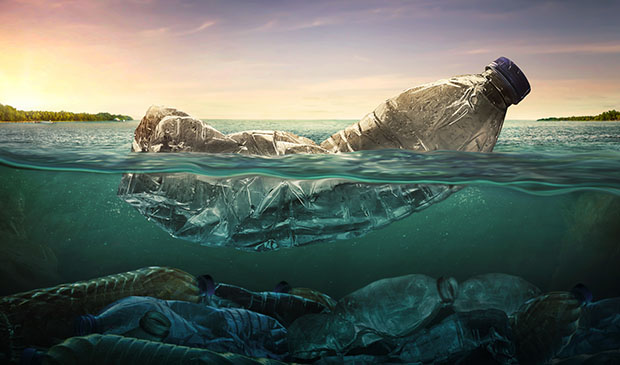On 19 June 2019, SCI's Environment, Health & Safety group and RSC's Environmental Chemistry, Toxicology and Food groups hosted 'Plastics, from Cradle to Grave and Resurrection' at SCI HQ, London.
Tiffany Hionas
In a drive to reduce global plastic pollution, we are continuously developing plastic reduction strategies to create scalable solutions. The SCI Environment, Health & Safety group’s event on plastics highlighted recent, innovative breakthroughs in the field and society's growing involvement in sustainable activities, which is driven by impactful behaviour changes over the last couple of decades.
These highlights were illustrated by three different speakers who have targeted where changes can be made to help solve the crisis.
Packaging and plastics
Stuart Foster, CEO of RECOUP, works to ensure that RECOUP delivers change through increased recycling and better use of plastic resources. Currently, RECOUP aims to facilitate a proactive approach to ensure that all parties, including designers, manufacturers, waste and resource management professionals and governments, are maximising the efficiency of plastic recycling.
Today, the emerging ‘cradle-to-cradle’ concept aims to eliminate the negative environmental impact of plastic production and pollution and allows packaging material to be reused to create new packaging materials.
As sustainability concerns increase among the public, consumers desire sustainable packaging, such as packaging ‘intelligence’ that monitor product conditions. These are the biggest challenges facing packaging designers, in ensuring they meet consumers' expectations and reduce environmental impact.
RECOUP and the British Plastics Federation (BPF) have launched new guidelines to help packaging designers create plastic packing to help recycling plants identify, separate and recycle plastics easily. Big brands are especially encouraged to follow the guidelines to avoid their products ending up in landfill and instead move towards a circular economy.
A circular economy aims to contribute to climate goals, preserve the world’s resources, and reduce environmental damage from plastic. As companies build core competencies in circular design (redesigning products) to facilitate product reuse, we are preserving the economic value of products and materials.
Healthcare and plastics
Ruth Stringer from Health Care Without Harm spoke about the concerning facts surrounding polyvinyl chloride (PVC) – one of the world’s highest volume plastics – and its hazardous implications to human health.
The common toxic additive in PVC medical devices is a plasticiser known as DEHP, which is part of a group of chemicals called phthalates that are extremely toxic. Unfortunately, due to manufacturer inaction and lack of legislation, many of these medical devices are still in use.
PVC has one of the most toxic manufacturing processes, emitting hundreds of hazardous residues. Epidemiological studies have identified that exposure to phthalates can trigger or cause fertility impairment, female reproductive tract disease, early puberty in girls, asthma, thyroid effects, and adverse effects on the lungs, liver and kidney.
In the EU, phthalates are banned in children’s toys, but the same compounds are still allowed to be used in medical devices in neonatal intensive care units. EU legislation requires the labelling of hazardous substances, but this form of protection is non-existent in some countries.
UK recycling companies have exported tons of plastic waste in approximately 1,000 containers over recent years including plastics containing PVC, and consequently they have been recycled and reused in hospital settings with few regulations and controls.
While PVC is recyclable, it is not the solution, as it releases toxic human carcinogens like dioxin. Hospitals need to be more aware of the plastics they use, so they do not end up in landfill. If plastics were properly labelled, hospitals can be better informed to make decisions based on the toxicity and recyclability of medical tools.
Behaviour change
Although positive action has been made on investment and policy to reach zero plastic waste, Sally Beken from Innovate UK posed an important question – ‘how do we ensure delivery of change?’
While solving the technical and economic issues associated with plastics use would bring us closer to a solution, Beken argued that we need to ensure we understand human behaviour and attitudes towards plastic waste, including the cultural and societal nuances that play a significant role in governing how and how much people recycle.
As people are driven by intuitive processes including habit, social influence, emotion and heuristics, we have evolved to prioritise ‘fast and frugal’ processes that underpin most of our daily actions which includes how we daily recycle.
Something to take away from Beken’s discussion is our need to concentrate on implementing methods which will ‘nudge’ the everyday consumer to reduce and recycle that will drive more environmentally-friendly behaviour among the population.
One of the challenges we are currently facing is the fact that recycling plastic packaging offers uncertainty to consumers, as many are unsure over which plastics can be recycled. Subsequently, material often enters the wrong waste stream and becomes lost to the economy.
Changing behaviours at a large scale is extremely difficult with the need for consumer to move from intent to action for a difference to be made. Implementing new methods for behaviour change to happen is at the heart of many researchers and policymakers, to ensure that with any plastic strategy or infrastructure, positive environmental and social change becomes the outcome.
Related links:
- SCI's Environment, Health and Safety Group
- Solving the plastics conundrum
- Gove outlines new plan to reduce plastic waste
- Bioplastics go mainstream

